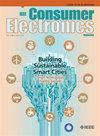DPSO-NAS: Wall Crack Detection Algorithm Based on Particle Swarm Optimization NAS
IF 10.9
2区 计算机科学
Q1 ENGINEERING, ELECTRICAL & ELECTRONIC
引用次数: 0
Abstract
As urbanization progresses, building surfaces increasingly suffer from degradation and structural damage due to prolonged environmental stress, raising significant safety concerns. Consumer-grade drones with embedded vision technology offer a promising approach for intelligent detection of architectural surface anomalies. However, reliance on manually designed network architectures limits their effectiveness, as these struggle to represent complex textures, reduce crack segmentation accuracy, and fail to efficiently leverage the heterogeneous computing resources of drones, hindering widespread adoption in building inspections. To address these issues, we propose a Neural Architecture Search framework based on Dynamic Particle Swarm Optimization (DPSO-NAS). This framework introduces a hardware-aware search space to dynamically adapt architectures to drone computational constraints, a dual-path feature fusion unit using anisotropic convolution to enhance crack feature extraction, and an automated evaluation mechanism to eliminate human bias and ensure optimal model convergence. Experiments show DPSO-NAS outperforms manually designed networks by 4.7–12.3 percentage points in classification accuracy on CIFAR and ImageNet16-120 datasets. In crack segmentation, it achieves a 77.4% mIoU and reduces edge localization errors by 38.6%. On mainstream drone platforms, it improves inference speed by 2.1 times and cuts power consumption by 57%, advancing efficient, scalable inspection solutions.DPSO-NAS:基于粒子群优化的墙体裂纹检测算法
随着城市化进程的推进,由于长期的环境压力,建筑表面越来越多地遭受退化和结构破坏,引起了重大的安全问题。具有嵌入式视觉技术的消费级无人机为智能检测建筑表面异常提供了一种很有前途的方法。然而,依赖人工设计的网络架构限制了它们的有效性,因为它们难以表示复杂的纹理,降低了裂缝分割的准确性,并且无法有效地利用无人机的异构计算资源,阻碍了在建筑检测中的广泛采用。为了解决这些问题,我们提出了一个基于动态粒子群优化(DPSO-NAS)的神经结构搜索框架。该框架引入了一个硬件感知的搜索空间来动态调整架构以适应无人机的计算约束,一个使用各向异性卷积的双路径特征融合单元来增强裂缝特征提取,以及一个自动评估机制来消除人为偏见并确保模型的最优收敛。实验表明,DPSO-NAS在CIFAR和ImageNet16-120数据集上的分类准确率比人工设计的网络高4.7-12.3个百分点。在裂缝分割中,mIoU达到77.4%,边缘定位误差降低38.6%。在主流无人机平台上,它的推理速度提高了2.1倍,功耗降低了57%,推进了高效、可扩展的检测解决方案。
本文章由计算机程序翻译,如有差异,请以英文原文为准。
求助全文
约1分钟内获得全文
求助全文
来源期刊
CiteScore
7.70
自引率
9.30%
发文量
59
审稿时长
3.3 months
期刊介绍:
The main focus for the IEEE Transactions on Consumer Electronics is the engineering and research aspects of the theory, design, construction, manufacture or end use of mass market electronics, systems, software and services for consumers.

 求助内容:
求助内容: 应助结果提醒方式:
应助结果提醒方式:


